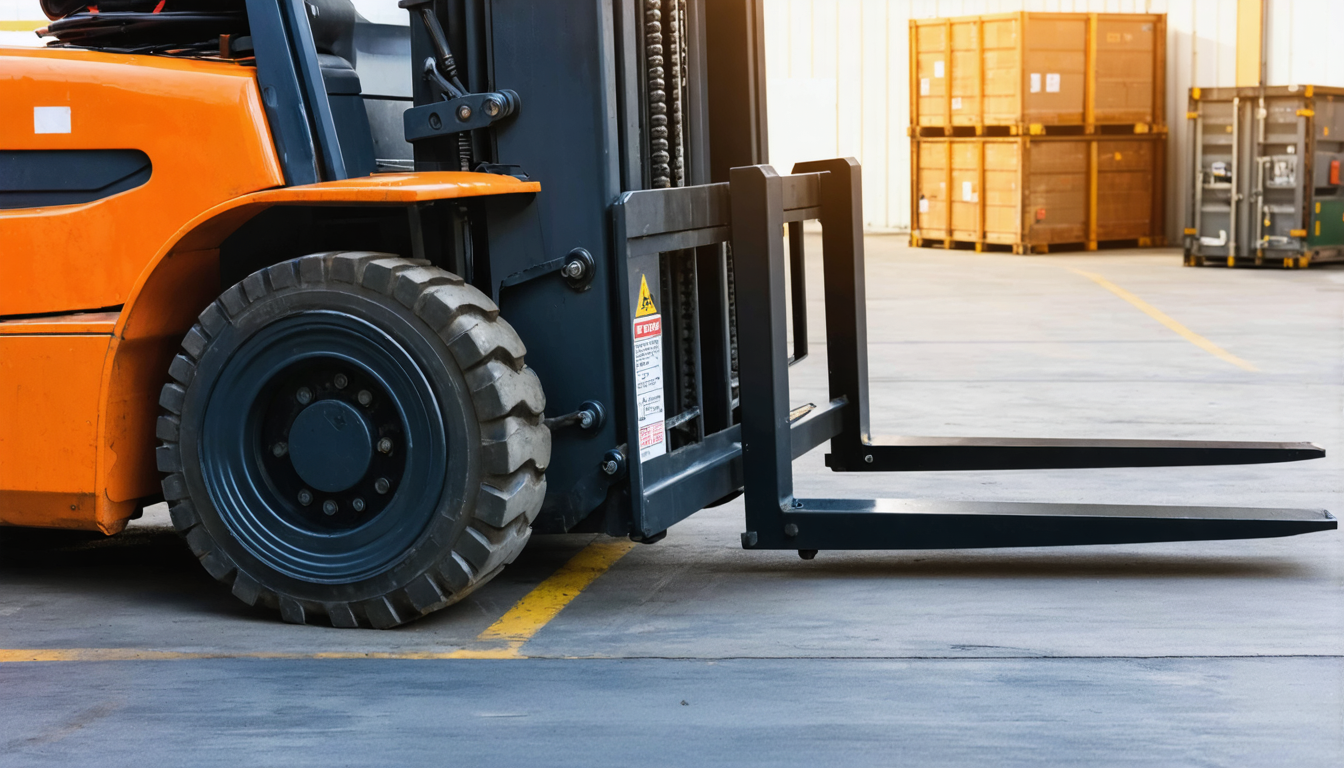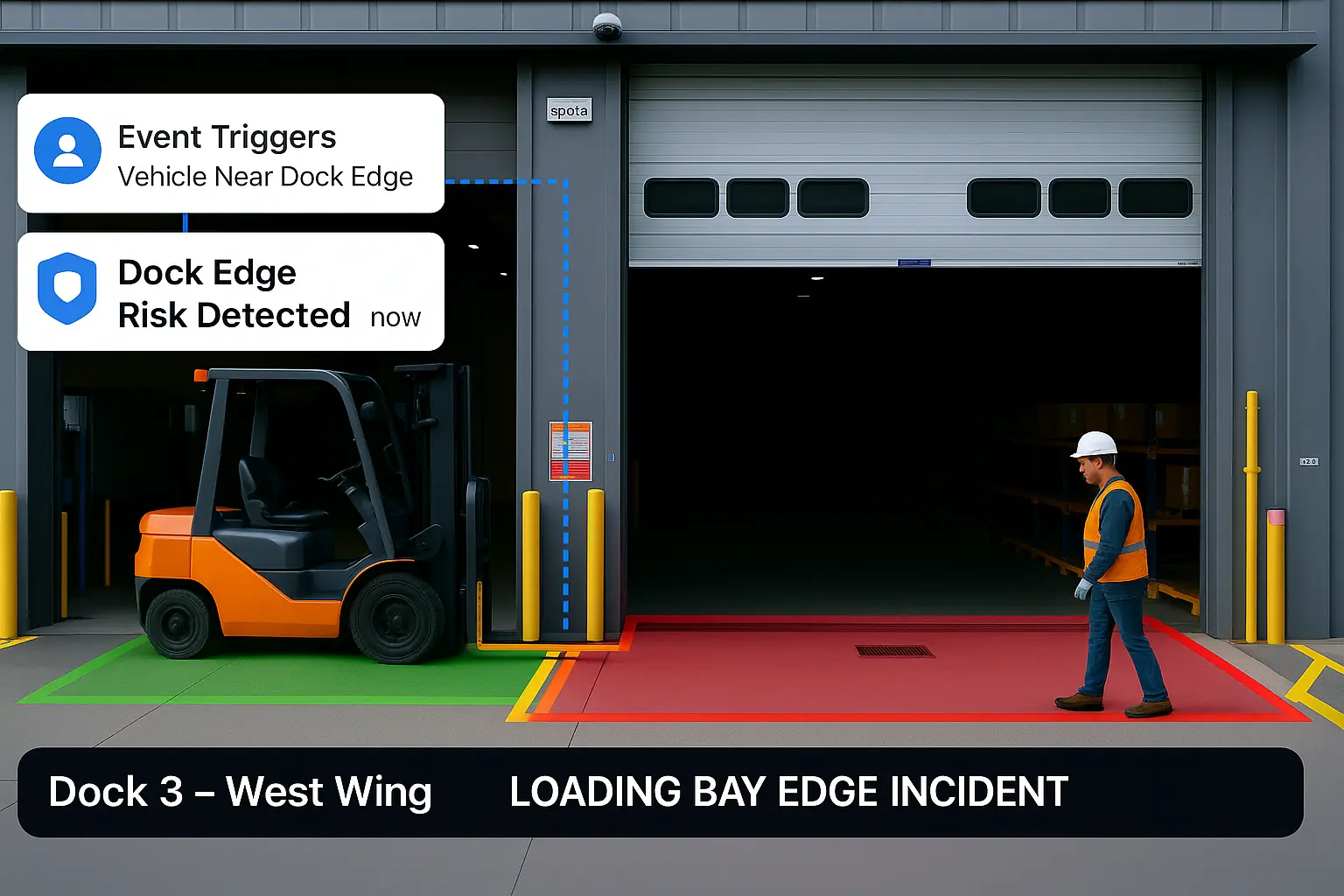Each year, falls from height and loading dock incidents cost the logistics industry billions—both in direct expenses and operational headaches. In 2023 alone, loading dock accidents contributed to 25% of all industrial injuries, while falls from height remained a leading cause of serious harm (Source: Work Zone Safety, 2025; BLS, 2023). The logistics sector reported 5 non-fatal injuries per 100 workers annually, with severe cases like fractures and amputations occurring at a rate of 3.7 per 100 workers (Source: BLS, 2023; ElectroIQ, 2025).
But here’s the upside: most of these incidents are preventable. With a blend of robust safety protocols and smart technology—especially AI-powered video analytics—logistics teams can shift from investigating incidents after the fact to stopping them before they start. This guide breaks down the true costs, root causes, and provides a clear framework for moving from a reactive to a proactive safety model using modern technology.
Why Falls from Height and Loading Dock Incidents Are Costly to Logistics Operations
Falls from height and loading dock injuries don’t just hurt people—they disrupt entire logistics operations. Direct costs include medical bills, workers’ comp, and legal settlements. Indirect costs—lost productivity, delays, damaged cargo, and compliance headaches—quickly add up.
Beyond the numbers, every incident means time spent on investigations, OSHA reporting, retraining, and often, overtime or substitute staffing. OSHA penalties add another layer, with average fines for these incidents at $10,272, and maximums reaching $52,016.
The bottom line: Falls from height and loading dock incidents aren’t just statistics—they’re operational threats that demand a smarter, more proactive approach.
The Top 5 Reasons for Falls from Height and Loading Dock Incidents in Logistics—and How to Prevent Them
Understanding the true root causes is the first step to reducing incidents. Here are the five leading causes in logistics, with practical prevention advice and how AI video analytics can elevate your safety game.
1. Inadequate Fall Protection
The Hazard: A warehouse team is rushed to meet a delivery deadline. A worker climbs onto a trailer to adjust a load, skipping the harness “just this once.” While reaching, he loses balance and falls to the concrete dock below, sustaining a fractured hip. Inadequate or missing guardrails, harnesses, and safety nets are a leading cause of falls in logistics.
Traditional Prevention:
Install guardrails, safety nets, and use harnesses for elevated work.
Require pre-shift inspections of all fall protection equipment.
Enforce strict “no work at height without protection” policies.
How AI Amplifies Prevention: AI-powered video analytics can monitor elevated work zones for real-time fall hazards. Using “Possible Fall” detection, safety teams are instantly alerted when someone slips, trips, or falls—speeding response and helping pinpoint high-risk areas for targeted improvements. Over time, heatmaps and incident data help leaders identify patterns and address gaps in fall protection before accidents happen.
2. Unsafe Vehicle Movements and Dock Edge Risks
The Hazard: A forklift operator is unloading pallets near a busy dock edge. With multiple trucks arriving, one vehicle suddenly moves before the dock lock is engaged. The forklift nearly tips off the edge, narrowly missing a serious incident. Uncontrolled truck access, improper braking, and vehicles entering no-go zones create dangerous blind spots on loading docks.
Traditional Prevention:
Use wheel chocks and vehicle restraints on every docked truck.
Designate clear vehicle lanes and no-go zones with paint and signage.
Enforce dock-lock checks before loading or unloading begins.
How AI Amplifies Prevention: AI systems can detect and alert teams when a vehicle or forklift enters a restricted zone or approaches the dock edge. Real-time “Vehicle Enters No-go Zones” and “Forklift Enters No-go Zones” alerts allow for immediate intervention, while historic data highlights recurring risk areas. This proactive monitoring ensures policies are followed—even when supervisors can’t be everywhere at once.
3. Slips, Trips, and Congestion on the Dock

The Hazard: It’s a rainy morning and the dock is crowded. Wet floors, stray pallets, and hurried foot traffic combine for a perfect storm—an employee slips while carrying a heavy load, spraining an ankle and missing a week of work. Slips and trips are especially common on slick or cluttered loading docks.
Traditional Prevention:
Keep walkways clear and dry, using non-slip mats and regular cleaning.
Mark hazards and deploy “Wet Floor” signs promptly.
Rotate shifts to avoid congestion and fatigue.
How AI Amplifies Prevention: AI-driven video analytics detect “Crowding,” “Running,” and “Possible Fall” events in real time. When congestion or unsafe movement is flagged, supervisors can deploy staff to clear hazards or reroute traffic before slips escalate. Reviewing flagged incidents also helps prioritize facility upgrades—like better drainage or anti-slip flooring.
4. Equipment Misuse and Mechanical Failures

The Hazard: A new hire operates a dock leveler incorrectly, causing the platform to drop unexpectedly. Nearby, a malfunctioning forklift with a broken seatbelt nearly tips during a sharp turn. Equipment misuse and mechanical failures are root causes in many severe incidents.
Traditional Prevention:
Require annual recertification for forklift and dock equipment operators.
Schedule routine equipment inspections and maintenance.
Clearly label and lock out defective equipment.
How AI Amplifies Prevention: Video analytics can flag “Forklift Near Miss” events and periods when forklifts are active in unsafe zones. This data supports targeted retraining and helps maintenance teams focus on high-risk assets. By automating the capture of near-misses and unsafe behaviors, safety leaders can spot trends and address problems before they turn into costly incidents.
5. Lack of PPE and Safety Training
The Hazard: A contractor starts unloading at the dock without steel-toed shoes or a high-visibility vest. Minutes later, a pallet slips, causing a foot injury that could have been prevented. Inadequate PPE use and insufficient safety training are persistent issues, especially with temporary staff and third-party drivers.
Traditional Prevention:
Mandate PPE checks at entry points and before shift start.
Conduct regular, hands-on training for all employees and contractors.
Post clear signage and distribute PPE at all high-risk areas.
How AI Amplifies Prevention: AI video technology can automatically detect “Missing Personal Protective Equipment” as workers enter designated zones. Instant alerts support immediate intervention, and historic data helps hold contractors and teams accountable. Combined with “Person Enters No-go Zones” insights, safety managers can ensure only trained, properly equipped people access hazardous areas.
Integrating a Modern AI Camera System: From NVR to AI Insights for Logistics
Upgrading your safety tech doesn’t mean starting from scratch. Modern AI camera platforms are purpose-built to work with your existing infrastructure—including the POE cameras you already own. There’s no need for a costly “rip-and-replace.” Instead, plug-and-play hardware connects your warehouse cameras or dock cameras to a secure, cloud-native dashboard.
How does this differ from a standard NVR system? Here’s the breakdown:
Feature | Standard NVR System | Modern AI Camera Platform |
|---|---|---|
Camera Compatibility | Requires new models | Works with existing POE/legacy cams |
Storage | On-premise, limited | Secure, cloud-native, scalable |
Maintenance | Frequent, on-site | Minimal, remotely managed |
User Access | Limited seats | Unlimited users, unified dashboard |
Video Review | Manual, slow | AI-powered search & incident alerts |
Insights | Passive footage | Real-time alerts for falls, vehicles, crowding |
What’s the real value? The AI analysis layer transforms every camera into a safety sensor—flagging “Possible Fall,” “Forklift Near Miss,” or “Vehicle Enters No-go Zones” events in real time. This doesn’t replace your people; it supercharges their ability to spot hazards, respond faster, and learn from every incident.
Practical integration tips:
Start with a risk assessment—map your highest-incident zones and current camera coverage.
Choose a platform that’s open and scalable, supporting both legacy and new cameras.
Ensure unlimited user seats, so safety isn’t siloed to one office or shift.
Align video analytics with your broader safety program—integrate with incident reporting, training, and regular OSHA audits.
Transform Your Approach to Logistics Safety—Book a Safety Consultation
Every fall or loading dock incident is more than a statistic—it’s a call to improve. With modern AI video analytics, you can prevent injuries, streamline investigations, and create a safer, more resilient operation. Ready to see how AI-driven video insights can empower your team to prevent the next incident? Book a consultation with Spot AI’s experts and get tailored, actionable guidance for your operations.
Frequently asked questions
What are the most common causes of falls from height and loading dock incidents in logistics?
The leading causes are inadequate fall protection, unsafe vehicle movements and dock edge risks, slips and congestion on the dock, equipment misuse or mechanical failures, and lack of PPE or training (Source: OSHA, 2025; TOSHA, 2025).
How can logistics companies implement safety technology without disrupting operations?
Modern AI camera platforms connect directly to your existing cameras, overlaying analytics without interrupting daily workflows. They automate hazard detection and reporting, supporting your staff and streamlining investigations—without downtime.
What compliance standards do I need to consider for fall and dock safety?
OSHA 29 CFR 1910.140 requires fall protection for work at heights of 6 feet or more. OSHA 29 CFR 1910.178 mandates forklift operator certification and safe load protocols. Regular safety audits and targeted training are also best practice (Source: OSHA, 2025).
What practical steps should I take before adopting AI video analytics in my warehouse?
Begin with a risk assessment. Identify your highest-risk areas, review current video coverage, and involve your IT and safety teams from the start. Run a pilot in a problem area, review the results, and scale up based on real data and team feedback.
How does AI-powered video help with incident investigations and prevention?
AI video platforms automatically flag incidents—such as possible falls, near-misses, or vehicles in no-go zones—making it easy to review footage, identify root causes, and support faster, more accurate investigations for compliance and insurance.
How can safety technology help reduce stress for safety managers?
AI-driven analytics automate hazard detection and reporting, freeing safety managers from constant manual monitoring. This lets them focus on coaching, training, and continuous improvement—making safety leadership more strategic and less reactive.
About the author
Joshua Foster
IT Systems Engineer, Spot AI
Joshua Foster is an IT Systems Engineer at Spot AI, where he focuses on designing and securing scalable enterprise networks, managing cloud-integrated infrastructure, and automating system workflows to enhance operational efficiency. He is passionate about cross-functional collaboration and takes pride in delivering robust technical solutions that empower both the Spot AI team and its customers.

























.png)
.png)
.png)